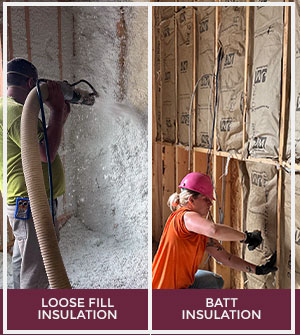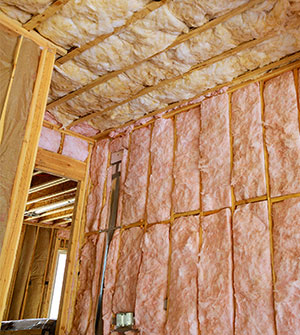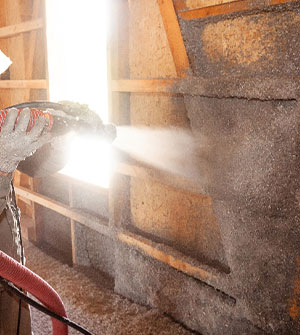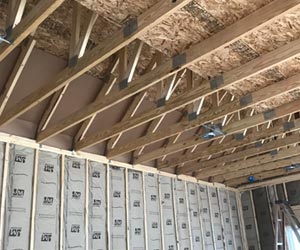Why Michigan Homes Need Proper Insulation
Michigan homeowners know the challenge of keeping comfortable through icy winters and humid summers. Heating and cooling account for nearly half of a typical home’s energy use, so choosing the proper home insulation directly impacts comfort and cost. Among the most popular insulating materials are fiberglass and cellulose. In this blog, we’ll focus on fiberglass insulation vs cellulose insulation- what they’re made of, how they work, and which one is the right choice for your home.
Understanding Insulation Basics
At the core of every insulation material is its R-value, the measure of resistance to heat flow. The higher the R-value, the stronger the thermal insulator.
Fiberglass insulation comes in two main forms:
- Batt insulation: Pre-cut sections, commonly referred to as blanket insulation.
- Loose fill insulation: Small particles blown into cavities for complete coverage.
For maximum energy efficiency, insulation should be paired with proper air sealing and ventilation. This helps reduce drafts, prevent moisture issues, and maintain a comfortable temperature in your home, whether it’s warm in the winter or cool in the summer.

Fiberglass Insulation: How It Works
Fiberglass is one of the most widely used insulation products in both residential and commercial construction. It’s made from tiny glass fibers spun from molten glass—often containing 40–60% recycled content.
Fiberglass works by trapping pockets of air within the material, which slows down resisting heat flow. This makes it an effective thermal insulator when properly installed.
Benefits of Fiberglass Insulation
Fiberglass offers several advantages that make it a cost-effective choice for Michigan homeowners:
- Affordable & widely available: Easy to source and budget-friendly.
- Fire resistance: Naturally non-combustible, fiberglass won’t burn or support mold growth.
- Moisture resistance: Repels water rather than absorbing it.
- Versatile installation: Available as batts/rolls or loose fill.
- Lightweight & easy to cut: Batts are designed to fit standard wall studs, ceilings, and floors.
High-density fiberglass batts can even reach R-15 in 3 ½-inch walls, making them a solid choice for meeting Michigan’s heating and cooling demands.

Drawbacks to Consider
While fiberglass is a strong option, it’s not perfect:
- Lower R-value per inch compared to cellulose (R-2.2 vs. R-3.5–3.8).
- Installation safety: The tiny glass fibers can irritate skin, eyes, and lungs, requiring long-sleeved shirts, gloves, and masks during installation.
- Potential settling: In some applications, fiberglass can sag or lose effectiveness if not installed correctly.
- Limited air sealing: Fiberglass reduces heat flow but won’t block air leaks as effectively as spray foam insulation.
Cellulose Insulation: What You Need to Know
Cellulose insulation is another widely used home insulation material, made primarily from recycled paper products, typically with 82–85% recycled content. Treated with borate compounds, cellulose gains added fire resistance and pest protection, making it a durable and eco-friendly option for Michigan homes.
Advantages of Cellulose Insulation
- Higher R-value per inch: Provides R-3.5 to R-3.8, offering stronger performance than fiberglass in the same space.
- Excellent coverage: Loose-fill cellulose is ideal for filling irregular cavities, reducing air pockets, and creating a more continuous insulating layer.
- Eco-friendly choice: With a high recycled content and lower embodied energy in production, it’s one of the most sustainable insulation products
- Sound dampening: Dense fibers help block sound transfer between rooms.
- Durability: When professionally installed, cellulose generally does not settle significantly, maintaining its insulating properties over time.

Drawbacks of Cellulose Insulation
- Moisture concerns: Unlike fiberglass, cellulose can absorb water. If exposed to leaks or poor ventilation, it may lose effectiveness and promote mold.
- Installation needs: Typically requires professional insulation installation equipment for blown-in applications, limiting DIY options.
- Weight factor: Heavier than fiberglass, which may limit use in some retrofit projects.
- Drying time: In wet-spray applications, cellulose requires a drying period before finishing walls.
Michigan-Specific Recommendations
Michigan spans climate zones 5A, 6A, and 7 (in the Upper Peninsula), which require robust insulation to handle snow, ice, and humidity. According to building codes and Energy Star guidelines:
- Attics: R-49 to R-60
- Exterior walls: R-20 to R-21 minimum
- Ice dam prevention: At least R-38 in the attic, combined with proper ventilation
Addressing moisture control is critical to avoid mold and mildew in Michigan homes. Always air-seal before insulating to achieve the best results.
Choosing the Right Insulation for Your Home
Both fiberglass and cellulose can deliver long-term energy savings when installed correctly. Consider:
- Your home’s construction and climate zone
- The balance between upfront cost and performance
- Moisture conditions and ventilation needs
- Professional vs. DIY feasibility
Working with a local contractor ensures your insulation choice meets Michigan’s unique requirements.
Trust Whitson Insulation for Michigan Homes
Since 1978, Whitson Insulation has provided trusted insulation services to the Grand Rapids community and beyond. Our team can evaluate your home, explain the benefits of fiberglass and cellulose insulation, and recommend the ideal solution for your project.
Contact Whitson Insulation today to schedule a consultation and discover how the proper insulation can keep your home comfortable and efficient throughout the year.
References
Center for Sustainable Systems, University of Michigan. (n.d.). Life cycle analysis of a residential home in Michigan. https://css.umich.edu/research/projects/life-cycle-analysis-residential-home-michigan
Michigan State University Extension. (n.d.). Improving home insulation for savings and comfort part 2: Types of insulation. https://www.canr.msu.edu/news/improving_home_insulation_for_savings_and_comfort_part_2_types_of_insulatio
Michigan State University Extension. (n.d.). MSHDA reference guide [PDF]. https://www.canr.msu.edu/spdc/uploads/files/energycodes/MSHDA%20Reference%20Guide.pdf
Meyer Fire Protection. (n.d.). What is considered non-combustible insulation? https://www.meyerfire.com/daily/what-is-considered-non-combustible-insulation
National Weather Service. (n.d.). Roof ice dams. https://www.weather.gov/grr/roofIceDams
State of Michigan. (n.d.). Residential energy efficiency checklist [PDF]. https://www.michigan.gov/-/media/Project/Websites/egle/Documents/Programs/MMD/Energy/resources/residential-chklst.pdf?rev=763779a0fa6d41b08d48e78b0cf563ef
U.S. Department of Energy. (n.d.). Insulation. Energy Saver. https://www.energy.gov/energysaver/insulation
U.S. Department of Energy. (n.d.). Insulation materials. Energy Saver. https://www.energy.gov/energysaver/insulation-materials
U.S. Environmental Protection Agency. (n.d.). A brief guide to mold, moisture, and your home. https://www.epa.gov/mold/brief-guide-mold-moisture-and-your-home
U.S. Environmental Protection Agency & U.S. Department of Energy. (n.d.). Insulation R-values. ENERGY STAR. https://www.energystar.gov/saveathome/seal_insulate/identify-problems-you-want-fix/diy-checks-inspections/insulation-r-values
Whitson Insulation. (n.d.). Fiberglass or cellulose for your Michigan home? https://www.whitsongr.com/fiberglass-or-cellulose-for-michigan-home/

